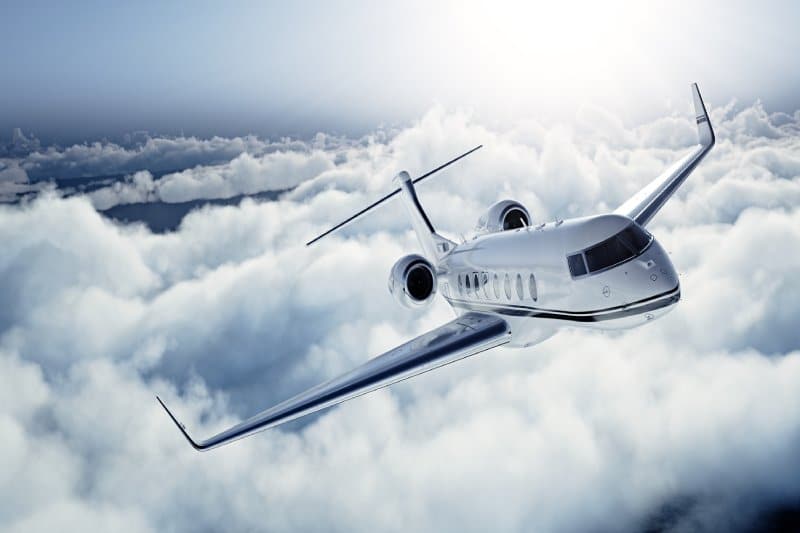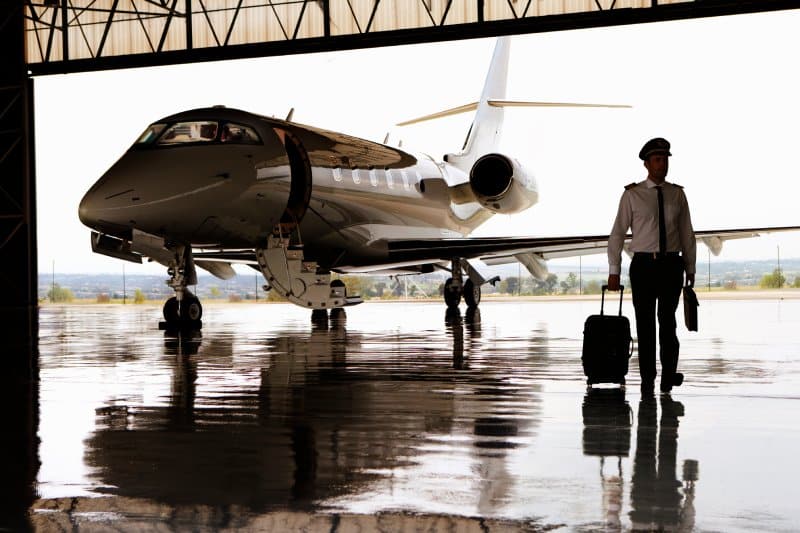Quick Navigation
- Understanding Private Jet Safety Measures
- How Safe are Private Jets?
- Are Private Planes Safer Than Cars?
- Are Private Jets Safer Than Helicopters?
- Are Old Private Jets Safe?
- How Often Do Private Airplanes Crash? Private Jet vs Commercial Airline Safety Concerns
- What Do the Private Jet Safety Statistics Tell Us About the Most Dangerous Part of a Flight?
- Are Private Planes Safe When It Comes to Turbulence?
- Will There Be Turbulence in a Private Jet Flight Over the Atlantic?
- Stratos Jet Charters: Prioritizing an Impressive Safety Record
Dreaming of skipping security lines and reclining in plush leather seats on your own personalized flight? Private jet travel offers luxury, convenience, and ultimate control. But amidst the champagne flutes and jetlag-defying schedules, a crucial question arises: are private jets safe?
You’ll be happy to know that they are in fact extremely safe. Between modern technology and logistics, as well as proper planning, management and routine maintenance, safety remains a top priority across private jet companies.
Let’s explore the details.

Understanding Private Jet Safety Measures
How Safe are Private Jets?
When it comes to personal private jets and business aircraft operations, it’s all about the safety management system put in place. There are some instances when private jet operations and safety standards are left by the wayside. For example, many only fly with one pilot, which can be a problem.
Stratos Jet Charters, Inc. makes it our 100% guarantee that there will always be two highly trained pilots in the cockpit, and that all necessary safety guidelines are met.
Bringing two pilots on board is not required in the air charter business, but is considered a safety expectation for Stratos. We will never contract with an air carrier that doesn’t live up to this qualification and the other safety requirements that we demand of our air carriers. Another thing that we do to expand the margin of safety is recommend the aircraft with the performance characteristics to meet the clients exacting requirements.
The truth is that there are specific aircraft that are certified for single-pilot operations. In those cases, poorly capitalized companies will under-bid other companies by cutting costs on crew expenses (where allowed by law).
Before contracting with an air carrier, we audit their operational history to ensure there are no accidents or enforcement actions taken against them since we’ve last worked with the carrier.
Once booked, Stratos audits the specific aircraft to ensure it is properly certified. We analyze the crew to ensure they meet very high levels of experience in the type of plane you’ll be flying on and make sure the aircraft carriers have adequate insurance. We take aviation safety extremely seriously and follow rigorous safety standards.
Overall, when wondering, “Is flying private safe?”, it’s important to consider the advantages of private jets compared to other travel options. Their ability to navigate diverse conditions and land at smaller airports offers flexibility and often avoids congested airspaces. This adaptability contributes to a strong safety profile.
At Stratos Jet Charters, Inc., safety is our utmost priority. We go beyond industry-standard regulations, implementing rigorous internal protocols and conducting thorough evaluations of all contracted carriers. Our commitment has resulted in an impeccable track record: no fatalities or injuries have ever occurred on a Stratos-chartered flight.
Are Private Planes Safer Than Cars?
Traveling long distances often sparks a debate: car or plane? While both have their pros and cons, when it comes to safety, airplanes take the lead. Whether you fly privately or on a commercial flight, the statistics clearly show that flying is much safer than traveling by car.
In the 2022 airline safety performance report, Willie Walsh, Director General of the International Air Transport Association (IATA) points out, “Accidents are rare in aviation. There were five fatal accidents among 32.2 million flights in 2022. That tells us that flying is among the safest activities in which a person can engage.”
The fatal accident rate also improved to .16 per million sectors in 2022, a reduction from 0.27 accidents from the previous year.
In contrast, the National Highway Traffic Safety Administration (NHTSA) reports that 42,795 people died in motor vehicle traffic crashes in 2022. That’s 1.35 fatalities per 100 million miles traveled compared to just 0.16 for airplanes.
Are Private Jets Safer Than Helicopters?
Helicopters have a higher accident rate compared to private jets. Helicopter crashes result in about 1.3 fatalities per 100,000 flight hours while private jets have a rate of 0.16 per million flight hours.
The difference in flight dynamics plays a role in this contrast. Helicopters operate at lower altitudes, making them more vulnerable to turbulent weather and potential obstacles such as wires and buildings. Also, their ability to hover introduces unique risks, such as engine failure during takeoff or landing.
However, it’s not all bad news for helicopters. Modern helicopters incorporate advanced safety features like auto-pilot systems and crash-resistant structures. Additionally, reputable helicopter charter companies prioritize rigorous maintenance and pilot training, which significantly reduces risks.
Are Old Private Jets Safe?
The most important factor to the safest private jets is not their age but rather their meticulous upkeep. Reputable private jet operators prioritize rigorous maintenance schedules that go above and beyond the mandated requirements.
Each component, from the engines to the tiniest bolts, undergoes regular inspections and replacements, ensuring peak performance and airworthiness.
How Often Do Private Airplanes Crash? Private Jet vs Commercial Airline Safety Concerns
Now, there is, admittedly, a difference between the death toll of large commercial airliners and small private aviation craft (which, again, includes owner-operator craft that is not flown for commercial purposes under part 135 regulations).
On a commercial aircraft, there are fewer than 0.01 fatalities per 100,000 hours of flying. On a private plane, that number jumps to 2.3 fatalities per 100,000 hours flown.
So are private jets safer than commercial flights? While that is a noticeable bump–0.01 is much less than 2.30–there’s no arguing the fact that private aviation remains far less likely to end in a fatality than car travel.
What Do the Private Jet Safety Statistics Tell Us About the Most Dangerous Part of a Flight?
According to Boeing, research shows that takeoff and landing are the most dangerous parts of a flight. In fact, 49% of all accidents take place during the landing of the aircraft, and 14% of them take place during takeoff.
The reason for this is that during these times the pilots have much less time to make adjustments and corrections to solve problems that arise. There is more room for pilot error.
However, it’s worth noting that the National Transportation Safety Board indicates that even in the event of an accident during takeoff or landing, passengers still have a 95% chance of surviving the problem.
Are Private Planes Safe When It Comes to Turbulence?
Next comes the question that everyone wants to know the answer to: is turbulence worse on small private jets than on large airliners?
Turbulence during air travel is when a plane comes into contact with a patch of rough air. Normally, jets travel through smooth air–that is, they are in the smooth flows of wind. When gusts of wind or disturbances in air pressure appear, they shake the plane up and down and back and forth.
While turbulence can be unsettling, rest assured, modern private jets are built to handle it, and experienced pilots are trained to navigate it. Compared to larger commercial planes, private jets often cruise at higher altitudes, where air is calmer and turbulence less frequent. Their smaller size also allows for quicker adjustments in altitude and course, helping pilots dodge turbulent patches.
But, because bigger planes handle the buffetings of wind better than smaller planes, small private planes are going to feel the effects of turbulence more than larger planes. Smaller planes like a turbo prop typically fly at 30,000 feet, whereas a light jet may fly between 30,000 and 45,000 feet where they might experience more changes in the air.
There are a few things you can do if you want to fly private, however. You will (in the absence of a storm) find significantly less turbulence over flat land or open water. Also, early morning and late night flights have less turbulence because there is less wind at night and storms tend to dissipate during the nighttime hours.
Other things you can do are to arrange for a larger private plane, choosing to charter a heavy private jet as opposed to a light one.
Finally, if you are experiencing turbulence, it’s important to return to your seat, and you’ll find that you get the smoothest ride if you sit over the wing as it’s the main center of gravity for the plane and will provide the most stable conditions.
Will There Be Turbulence in a Private Jet Flight Over the Atlantic?
Yes, one of the routes that is considered to be the most turbulent is the flight from New York to London. This is because of the disruption of the jet stream. Most pilots will try to avoid it by flying north or south of it.
The problems over the Atlantic are less pronounced if flying from, say, Miami to Barcelona.

Stratos Jet Charters: Prioritizing an Impressive Safety Record
We hope that we have made it clear in this article how safe airplanes are. There will always be risks with every form of travel. There are risks to cars, trains, buses, and even to pedestrians and bicyclists. The best we can do is to minimize the risk as much as possible.
The aviation industry has set standards for business aircraft and other private jets that make sure that private plane flights are as safe as possible. And Stratos Jet Charters, Inc. takes that a big step further, making sure that an even more rigorous safety protocol is followed by all our jet carriers.
We firmly believe that when you are flying with Stratos Jet Charters, Inc. you are flying with the best.









